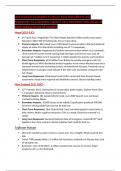Summary
Summary GCSE Geography Case Studies
Looking for comprehensive and reliable GCSE Geography case study notes? Look no further! Our detailed and concise study notes cover a wide range of topics and case studies. Our notes are organized in an easy-to-follow format, with key points, examples that are essential in understanding each cas...
[Show more]



